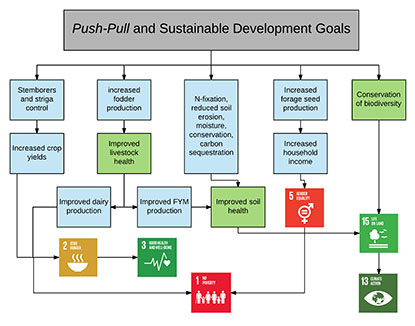The resolution, ‘Transforming our world: the 2030 Agenda for Sustainable Development,’ adopted by the UN General Assembly on 25 September 2015, emphasized holistic development and interlinkages: “The challenges and commitments identified (…) are interrelated and call for integrated solutions. To address them effectively, a new approach is needed.” [1]
The resolution is rooted in previous calls by policymakers and practitioners to break down the silos that have hampered development efforts in the past.
Agriculture is at the heart of the Sustainable Development Goals (SDGs) and key towards achieving them: the UN General Assembly recognized on 22 December 2015, “that agricultural technology will have a beneficial impact on and an important role in the successful implementation of the goals and targets of the 2030 Agenda for Sustainable Development”[2]. As shown by Le Blanc (2015), SDG 2 (zero hunger) is linked through targets to eight other SDGs: Climate Change, Sustainable Consumption and Production, Growth and Employment, Poverty, Health, Inequality, Gender and Terrestrial Ecosystems.[3]
While avoiding the pitfalls of identifying a panacea or developing a new silver-bullet approach, existing technologies that have an ecological foundation and are simultaneously embedded across the food system hold transformative potential. Below, we would like to introduce one such technology –Push-Pull – as an example of how a knowledge intensive solution developed to address biological constraints became a proven technology directly impacting SDG 2, but also SDG 1 (no poverty), SDG 5 (gender equality) and SDG 15 (life on land).

Maize production in Africa is constrained by two major pests: stemborers, which can cause yield losses of 20-80%, and Striga, a parasitic weed that attaches itself to the maize roots and can cause yield losses up to 100%. By the late 1990s, in search of an ecological solution to stemborers, scientists at the International Centre of Insect Physiology and Ecology (ICIPE), Kenya Agricultural Research Institute (KARI) and Rothamsted Research in the UK developed the biological pest management strategy to control the stemborer. By intercropping desmodium, a leguminous crop, the stemborer is repelled by its volatiles, causing a push away from maize. At the border of the plot, an attractant trap plant, Napier grass or Brachiaria, pulls the stemborer. As the border crop does not allow full development of the stemborer, the majority of the larvae die. Serendipitously, ICIPE researchers found that desmodium successfully suppresses Striga through an allelopathic effect causing suicide seed germination.
At the level of SDG 2, the ability to control these two major pests resulted in on-farm maize yield increases in Kenya from less than 1 ton per hectare to at least 3.5 tonnes per hectare. Furthermore, adapted for drier climate with drought-tolerant varieties, the climate-smart Push-Pull variant results in yield increases for sorghum from less than 1 ton per hectare to 2.5 tonnes per hectare.
At the level of SDG 1, these yield gains correspond with positive returns on investment for farmers of over 2.2 compared to negative returns from mono cropping, with revenue gains from US$351 to US$957 per hectare per year. In addition, the two companion plants are excellent sources of high-value fodder for livestock, doubling milk production and diversifying farmers’ income sources. Availability of dairy for home consumption, as well as increased self-sufficiency of maize combined with lower mycotoxins observed also indirectly impacted SDG 3 (good health and well-being).
At the level of SDG 5, Push-Pull is a gender-sensitive technology, with the majority of adopters being women due to targeted dissemination campaigns. In addition, scale-up efforts for the technology include the improved availability of both companion plants. Community-based seed production is one avenue pursued, whereby women’s groups are multiplying desmodium seeds and subsequently earn additional household income.
At the level of SDG 15, this perennial desmodium, as leguminous plant, provides for nitrogen fixation, reduces soil erosion, improves moisture conservation, and through the reduced need for plowing, increases carbon sequestration. Combined with the better health of livestock resulting in improved farm yard manure (FYM) production, Push-Pull has a significant impact on soil health. Furthermore, by not only reducing the need for use of pesticides, but also drawing on the service of beneficial insects, the technology contributes to the conservation of biodiversity, amplifying the direct impact on SDG 15 and indirect impact, through the climate-adapted Push-Pull on SDG 13 (climate action).
With over 100 scientific research articles published, Push-Pull is a proven and validated technology that breaks down the silos and takes advantage of synergies. As of the beginning of 2017, the number of adopters in East Africa has reached 140,000 farmers. With strategic start-up funding available, we are eager to scale-out the technology to Southern and West Africa. Trials are currently ongoing in Malawi and Zambia, with plans to expand to Rwanda and a West African country. For any interested parties, the adoption potential can be assessed using an interactive prototype map, with extensive research and dissemination material available via the Push-Pull website.
References
[1] United Nations. 2015. “Transforming our world: the 2030 Agenda for Sustainable Development.” General Assembly 70 Session. p.5.
[2] United Nations. 2016. “Resolution Adopted by the General Assembly on 22 December 2015.” Vol. 70/198.p.3
[3] David Le Blanc. 2015. “Towards Integration at Last? The Sustainable Development Goals as a Network of Targets. DESA Working Paper No. 141.
For additional information on Push-Pull:
Push-Pull Scientific Publications
Climate Smart Push-Pull Brochure